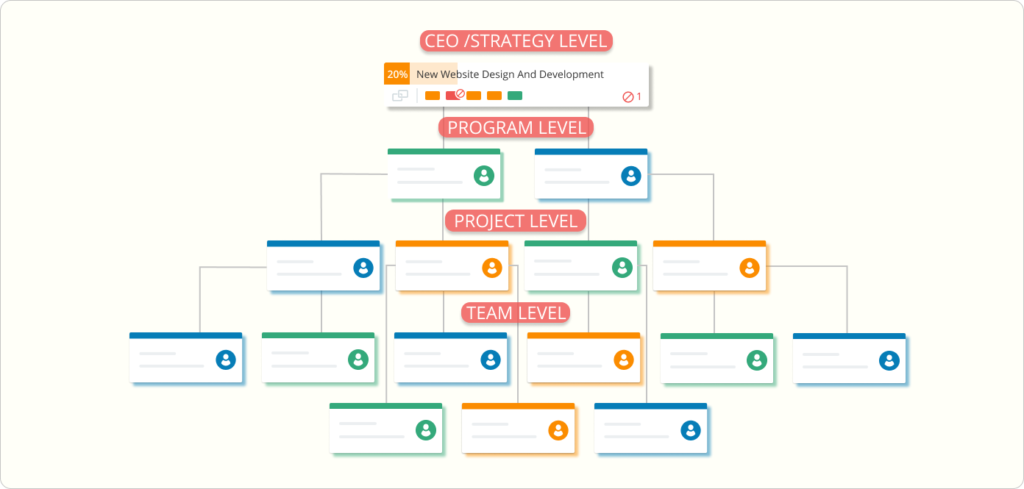The proper implementation of OKRs (Objectives & Key Results) can help you enable successful strategic execution. But before that, there are questions that need answering.
Even if you've written the perfect OKRs, a common dilemma is how to structure them at scale across the company. Should you cascade your OKRs from top to bottom? Or maybe align goals separately? How can you do that in practice?
Truthfully, there isn't a correct answer. As with many other things in work management, it depends on the context you're in.
Having said that, let's dive deeper into the topic below.
Cascading OKRs vs. Aligning Organizational Goals
To get straight into the nitty-gritty stuff, here's an example of cascading OKRs.
Imagine that your company sets a top-level objective such as "Enter the management reporting market". Obviously, that's an extensive goal that consists of many parts so that the final OKR might look like this:
| Objective | Enter the management reporting market |
| Key Result 1 | Enable advanced analytics in the product |
| Key Result 2 | Increase data/reporting leads by 40% |
| Key Result 3 | Sign 10 or more new partnerships with consultants |
Cascading this top-level OKR means making its key results direct objectives of specific teams or departments. For example, "Enable advanced analytics in the product" can become the main objective for the Engineering team. Their final team-level OKR might look like this:
| Objective | Enable advanced analytics in the product |
| Key Result 1 | Release 4 new advanced charts |
| Key Result 2 | Decrease data extraction incidents by 70% |
| Key Result 3 | Keep load time below 3 seconds |
The same idea applies to the rest of the key results types from the top-level OKR, which may be the objectives respectively of the "Marketing" and "Partnership" teams.
To sum up, this structure is easy to start with and enables clear coherence in the company. However, it's a top-down, "command and control" approach where teams have little flexibility over their own direction. For instance, imagine the top-level KRs are imperfect or start changing too often. This will prompt teams to constantly shift their objectives and abandon what they've already started working on.
OKR Alignment
Alternatively, the OKR alignment approach is more Agile-based. Instead of directly transforming top-level KRs into team-level objectives, it emphasizes collaboration with high-level management about how a specific team/department can support given strategic OKRs. In practice, this happens through regular OKR reviews to sync strategy.
Taking the example from above, the Engineering team is free to come up with their own objective. Keep in mind that it can still be the same as the top-level KR. However, the idea is for the Engineering department/team to agree on that KR collaboratively with high-level management.
Tip: To avoid confusion, we advise you to make your strategic OKRs "broader". Instead of having a top-level KR like "Enable advanced analytics in the product", turn it into something like "Become a reporting-friendly solution". This gives your teams more room for creativity to create aspirational OKRs that are not tied to a specific strategic measurement. It also allows greater flexibility to scale OKRs across multiple teams or departments.
Cascading/Aligning OKRs in Practice
As we have more context, let's take a practical look at cascading OKRs and aligning goals. To do that, visualizing your work activities on interconnected kanban boards can be a true ally.
Cascading Company into Team-Level OKRs
If you're not familiar with the Kanban method, you should know that at its core lies visualization and continuous improvement. That's why no matter what you might read online, keep in mind that Kanban scales beyond the team level, and it can help you optimize your management activities too.
So, if we assume you use a professional project portfolio management software like Businessmap (formerly Kanbanize), you can build multiple digital kanban boards that put on display everything from your high-level OKRs down to the individual tasks of a team member.
Within the system, this happens through Management (Portfolio) boards and Team boards. With the help of the former, you can build your company-level OKR. In Businessmap, we use initiatives (objectives) and "Measurable Outcomes" to do that. If we stick to our top-level OKR example from above, here's how it will look inside the software:
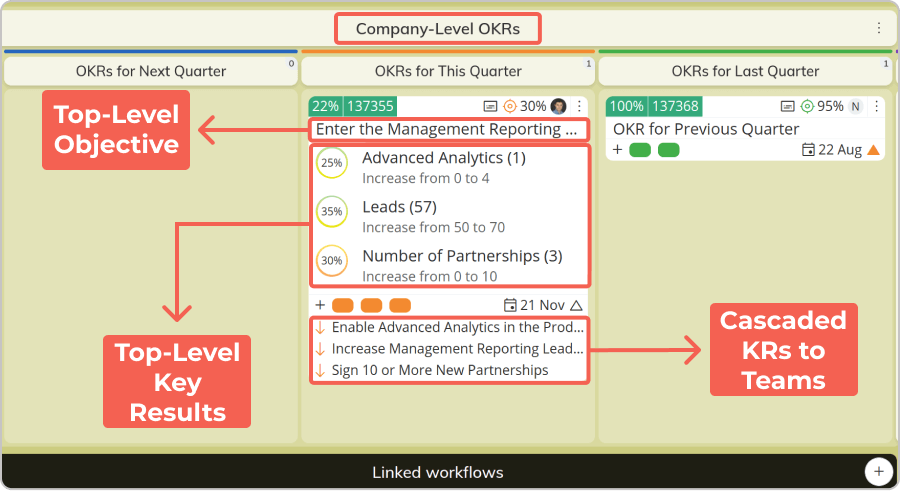 Visualizing Company-level OKRs on a Management Board
Visualizing Company-level OKRs on a Management Board
Going down to a team kanban board, you can visualize initiatives (objectives) and outcomes for the respective team, too (in our case, let's assume that's Engineering). Following the cascading structure from above, the first outcome/key result from the Management Board ("Enabled Advanced Analytics in the Product") will become an objective on the Engineering board. Therefore, the team-level OKR could look like this in practice:
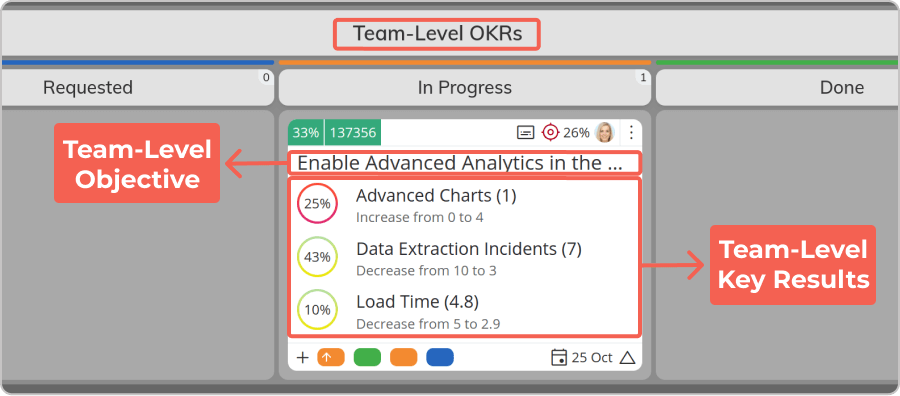 Cascading strategic objectives into team-level key results
Cascading strategic objectives into team-level key results
So far, so good, but how do you gain transparency over both company and team OKRs?
Well, the Management boards in Businessmap allow you to do that. Apart from high-level OKR visualization, you can connect specific workflows of multiple team/departmental boards in a single place and turn them into a true management hub. With the help of parent-child link relationships, the system allows you to build a hierarchical structure of your work activities and cascade OKRs across teams without losing sight of the top-level strategy.
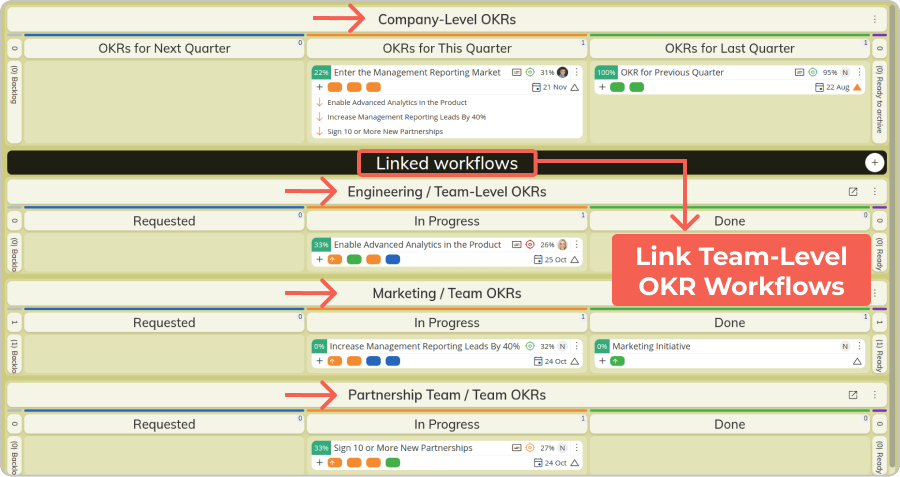 Gaining transparency over the company and team OKRs with Linked Workflows
Gaining transparency over the company and team OKRs with Linked Workflows
The Alternative: Aligning Company/Team OKRs at Scale
In practice, you can follow the same structure from above and just shift the concept when talking about OKR alignment.
While cascading can work for you initially, keep in mind that it can get messy quickly when you're looking to apply it at scale. Just imagine what a slow and cumbersome process it would be to constantly think about how you can transform high-level key results into lower-level objectives across a deep hierarchical structure.
That's why set up your strategic OKRs on the Management boards in Businessmap and give autonomy to lower-level departments or teams to come up with their own OKRs across their boards. Of course, don't forget to hold regular OKR cycle meetings (based on your business cycle - monthly, quarterly, yearly) on different levels to ensure that all goals across the company align with the strategic objectives that higher management has laid down.
To give an example, with the Management boards in Businessmap, you can create swimlanes or multiple workflows and visualize OKRs based on different verticals or products in your portfolio.
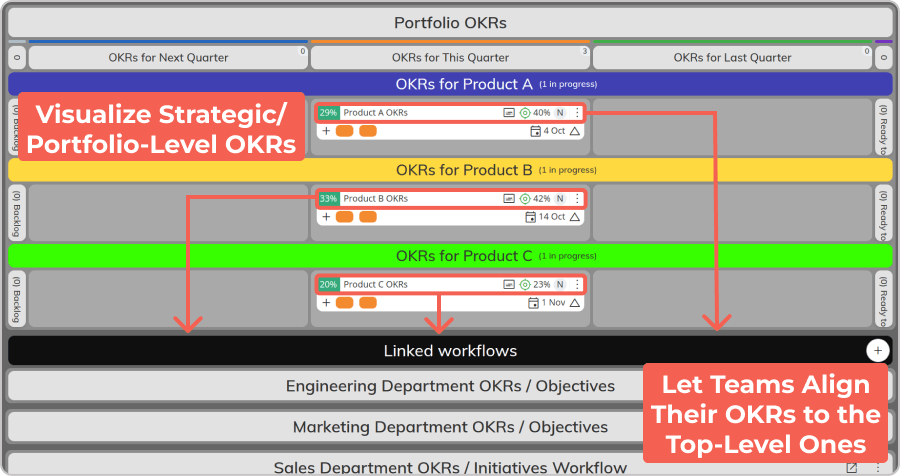 Departmental/Team managers should align their OKRs with the top-level ones
Departmental/Team managers should align their OKRs with the top-level ones
Having an overview of your strategy will allow mid-level managers, departmental heads, team leaders, etc., to start creating lower-level OKRs that reflect the main business priorities. The idea is to connect and align everything in a single place, so everybody knows what they should focus their efforts on and how to react if strategic changes occur.
To Align or to Cascade OKRs: That's the Question!
In conclusion, our answer would be to always strive toward aligning OKRs instead of cascading them. This way, you can achieve an OKR implementation at scale and be more agile whenever business priorities shift.
However, that doesn't mean cascading OKRs doesn't work. If your organizational environment consists of fewer hierarchical levels, then it might be a good solution for you initially because it creates a coherent structure.
But even then, don't operate in a "command and control" way where management blindly transforms top-level key results into lower-level objectives. Instead, aim to create a collaborative environment where you discuss your strategy with the relevant teams in charge of turning it into reality.
Kanban and Businessmap are here to help you create your OKR structure and connect it to daily work execution!
Try Businessmap Free for 14 days
Nikolay Tsonev
Product Marketing | PMI Agile | SAFe Agilist certified
Nick is passionate about product marketing and business development and is a subject matter expert at Businessmap. With expertise in OKRs, strategy execution, Agile, and Kanban, he continues to drive his interest in continuous improvement. Nick is a PMI Agile and SAFe Agilist certified practitioner.



